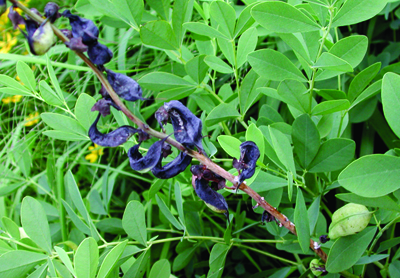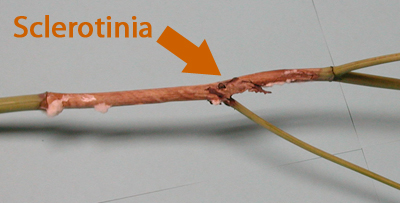Sclerotinia
July 8, 2015
Root and stem rots
Pathogen
Sclerotinia sclerotiorum.
Hosts Include
Anemone, Aquilegia, Aster, Bellis, Campanula, Coreopsis, Delphinium, Digitalis, Helianthus, Hosta, Iris, Liatris, Lupinus, Papaver, Platycodon, Rudbeckia and Scabiosa.
Symptoms
Pre- and post-emergent damping-off, crown rot, and blighting of foliage and petioles. Small, hard, irregular, black structures called sclerotia may be present on or in plant tissue (especially inside stem and petiole tissue). White, fluffy growth on affected plant parts is most readily visible in high humidity.

Dieback of a flower stalk of Baptisia caused by Sclerotinia sclerotiorum.
Spread
Sclerotia, long-term survival structures, are found in soil and on plant debris. The disease is primarily spread when these structures are moved. Disease can also be spread when infected plant material is moved. Under certain environmental conditions, mushroom-like structures (apothecia) are produced. These release air- borne spores.

Canker caused by Sclerotinia sclerotiorum. Note the white growth and the small sclerotia.
Management
Field soil should be sterilized before use in growing media. Susceptible crops should not be grown in areas with a history of white mold problems. Additionally, good sanitation is important to limit spread. Control weeds in production areas – some weeds are hosts to S. sclerotiorum. Fungicide drenches can protect plants from infection.
Print a PDF of this page: Sclerotinia



 Print
Print Email
Email



